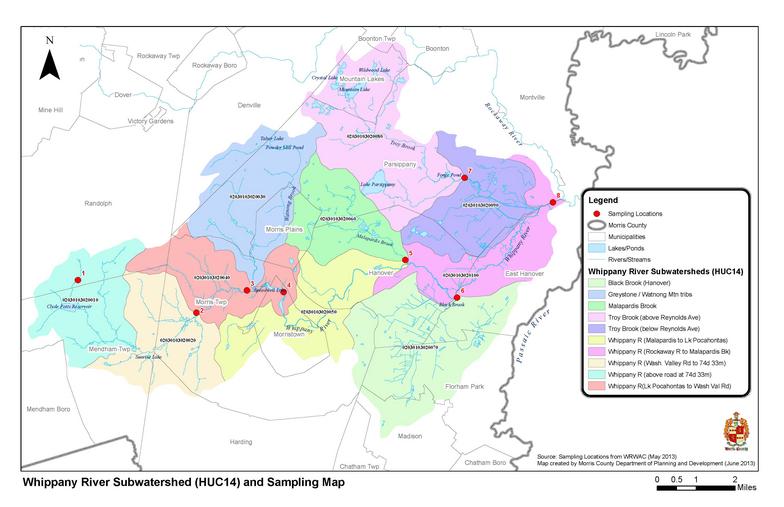Restoration and Protection
Reports and Actions
- 2012 Stream Bank Stabilization Report Lake Pocahontas by Princeton Hydro
- 2009 Pathogen Loading Data by Princeton Hydro from 8 sampling sites along the Whippany River
- 2005 Whippany Watershed Lakes Study
Water Quality Sampling
In 2008, the New Jersey Department of Environmental Protection, Division of Watershed Management, awarded WRWAC with a grant entitled “Section 319H NPS Pollution Control and Management Implementation Grant: Planning and Design of Priority Implementation Projects in the Whippany River Watershed”. This grant allowed WRWAC to assess the water quality during wet weather conditions at eight strategic sites throughout the watershed, from the headwaters in Randolph and Mendham to where the Whippany River meets the Rockaway River in Parsippany and East Hanover. Below is a GIS map of the eight stations, which are described in detail in the report prepared by Princeton Hydro, LLC.

From July through October of 2009, water quality samples were taken at the eight stations during wet weather events. The results of the testing are contained in Review of Pathogen Loading Data by Princeton Hydro LLC. The results from each of the eight stations start on page 58, and correlate with the table and the map. For the Latitude/Longitude table of location of testing sites, click here.
The focus of this project is the accurate and extensive characterization of the sources of fecal coliform contamination to the Whippany River and its tributaries. Fecal coliform is the sole focus of this project due to the spatial extent of the watershed. By addressing one parameter in such a large project area, the goal of achieving the Whippany River TMDL for fecal coliform will be more realistic. The uniqueness of this project is that it capitalizes on past watershed-wide efforts, in particular the recent, very comprehensive 2004 Whippany River Sanitary Study and the 2005 Whippany River Watershed Lakes Study, both conducted by Dr. George Van Orden and WRWAC. Essentially, the project picks up where those projects ended. The earlier projects involved the intensive monitoring of fecal coliform concentrations throughout the Whippany River watershed and the review of the data relative to historic water quality data. By targeting the data collection of the WRPP to fill specific gaps, refine and prioritize pollutant reduction strategies and present the results in an NJDEP-accepted framework for implementation, we will make full use of existing data and decades of past work, thus avoiding any duplication of efforts. Further refinement and identification of sources will be accomplished through the use of Microbial Source Tracking (MST) methodologies (specifically, Antibiotic Resistance Analysis (ARA)), visual watershed/stream assessments and land use/land cover analyses. A selected HUC 14 specific pollutant reduction project has been designed and implemented – the construction of a defined best management project.In summary, the goal of the project is to more accurately define the sources of fecal coliform contamination, and—most importantly—generate the WRPP framework, prioritized project list and project implementation timetable needed for the successful restoration of the Whippany River and the construction of a project which will implement a demonstrable reduction in the HUC 14 selected.